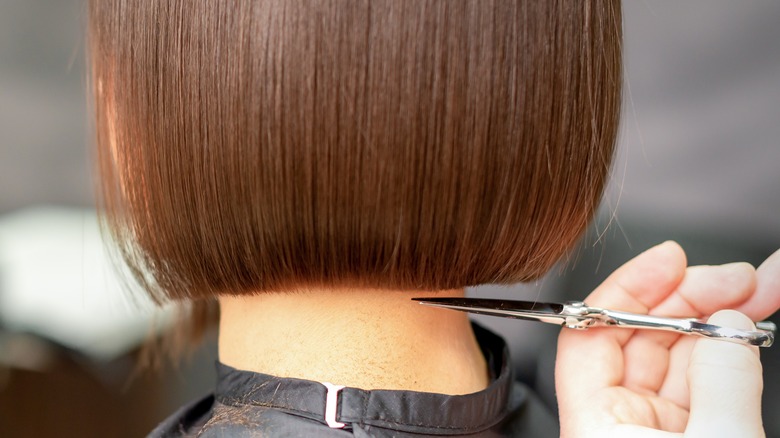How Often Should You Get A Haircut If You Have Short Hair?
We've all seen the trendy bob haircut come and go, but for some of us, short hair is a mainstay. There's no denying the benefits of having a shorter style, such as less fuss during styling. Depending on how short you go, you might not have to think about styling it at all, saving you time every morning. However, every hairstyle — regardless of length — requires a certain amount of maintenance. This means using the appropriate styling products for your hair type and routine trims to keep your tresses healthy.
As the American Academy of Dermatology Association (AAD) notes, there are a few simple ways you can do this. Applying conditioner after shampooing is one example — doing so can help your locks seal in moisture, preventing unwanted frizz and making it easier to style. Using shampoo and conditioner formulated for your hair type and specific concerns can also be beneficial. For example, a hydrating conditioner can help those with dry or damaged hair.
That being said, what about haircuts? We all know a routine trim is essential for getting rid of split ends, but is there an ideal time to get a cut for your specific hairstyle? You might assume that those with shorter hair need to see their stylist more often, and while this may be true, several factors play a role in the timing.
How often does short hair need to be cut?
If you have short hair, you can go up to one month without needing a haircut; however, you might need a cut as little as two weeks after your last appointment. Additionally, your need for a haircut will depend on factors, such as its thickness or curliness. Those with chemically processed tresses may also have to consider its impact on how often they visit the salon.
If you love your short hairstyle and you've heard rumors of frequent cuts resulting in quick regrowth, there's no need to panic — hair typically only grows about a half-inch per month, and cutting it regularly does not impact its growth rate.
As you look to keep up with your haircut appointments to maintain your short style, pay attention to your hair's shape. Celebrity hair treatment expert Philip B. told Good Housekeeping that those with short tresses often notice that they start to lose their shape around the four-week mark. This is a good rule of thumb to keep in mind, but don't hesitate to speak to your stylist as well — they have the expert knowledge and most experience with your hair, making them a valuable go-to resource. Ask them for their opinion next time you're at the salon.
Tips for maintaining your short hairstyle
Having short hair inevitably cuts down on the time it takes to style your tresses, but it doesn't come without the need for proper maintenance (aside from haircuts). As L'Oréal Paris explains, keeping your locks hydrated is still essential, especially the ends. An occasional deep conditioning treatment can go a long way, in addition to the use of a leave-in conditioner. Just remember that you don't need to use as much product. Using a smaller amount can help you prevent a weighed-down, oily look.
Another way to maintain the health and style of your short hair is to sleep with a satin or silk pillowcase. These types of pillowcases have become trendy, and for good reason — they help prevent the development of friction and tugging on your tresses. Additionally, the material is thought to help hair retain moisture, which can ultimately lead to less breakage.
Finally, you may want to consider washing your tresses more frequently, as short hair has a tendency to become oily more quickly. That being said, be sure to pay attention to your scalp, as you may need extra moisturizing if all of that washing results in dryness. A hydrating scalp masque can work wonders if you begin to notice any issues, such as dandruff. If you can't wash your locks as often as you would like, reach for the dry shampoo in a pinch.


